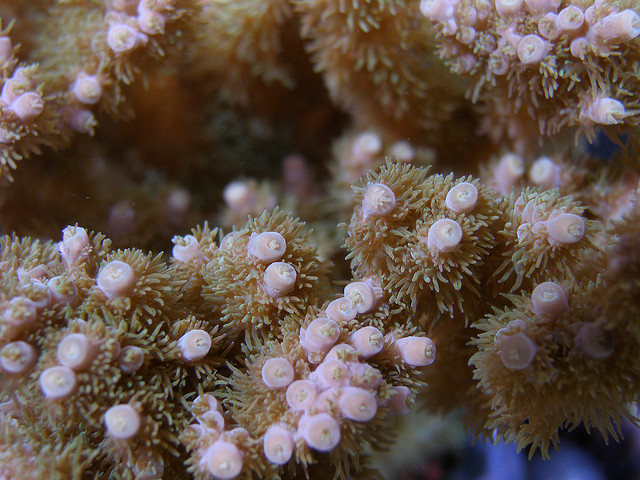Lately, there have been various assaults on lighting in many popular reefkeeping forums: The white light zealots attacking the Windex blue fanboys, and the T5/Metal Halide fans using coral color as evidence that LEDs are bad or wrong; fanaticism doesn’t do this hobby any good.
To base success with SPS on color alone is misguided, and it is especially misguided if someone declares a specific color range for a particular coral as an indicator of success or health (unless you’re a scientist and actually measuring fluorescence). In my strong opinion, the colors generated by Radiums and excessively blue T5 are not always natural.
That is not saying that blue lights are wrong or bad. From a hobbyist’s perspective, the coloration generated by blue bulbs is certainly desirable. But you probably get a better representation of the colors these corals exhibit in their natural setting IF you were to use 6,500 to 10,000K bulbs. Most of the corals farmed or collected are from very shallow reefs.
Here’s a picture of Cali Torts (Acropora tortuosa) growing in the ORA greenhouse under the sun. Is this color wrong or an indication of failure?
Hobbyists would rather see their Cali Tortuosa with more blue or purple. But catering your light to achieve more color does not necessarily mean anything more than you simply meeting your desire for prettier corals.
LEDs are the latest victims of this debate. Hobbyists attack LEDs because some of the legacy corals in this hobby express vastly different colors under LED. In my experience, Cali Torts tend to ‘green up’ within the inner branches from green fluorescent protein. My Oregon Mummy Eye has hints of orange where green is expected. “Pink Lemonade” acropora turns into a “Pink Lime”. But none of these changes indicate failure or that LEDs are bad. These differences of color are no more significant than comparing 10,000K and 20,000K metal halide tanks. Different is fun and interesting. It opens up great questions about pigment expression. Perhaps vendors can represent these corals on their under different lighting and help celebrate these differences.
If your goal is to emulate the colors that many retailers exhibit with their 20,000K bulbs, then by all means you should replicate their lighting. But 20,000K colors should not be considered ‘the standard’ that all other lights and coral colors are compared against.
In fact, we should ask ourselves a broader question. Is our quest for more color misguided? May we reach a point where our quest for more color compromises the long-term health of these corals? There are additives available to kill and reduce zooxanthallae in corals to unmask more color pigmentation. ULNS (ultra low nutrient systems) are the latest hot thing because browned out corals are undesirable. Browned out? A coral with a wealth of brown is a coral with a lot of symbiotic zooxanthellae. When corals undergo stress, they brown out. That means they are loading up on the symbionts that feed them and give them the nutrients to recover and grow.
If anything should be an indicator of health, it should be growth. Anyone veteran hobbyist will tell you corals calcify faster under lower kelvin bulbs. An Iwasaki 6,500K metal halide grows corals faster than a Radium bulb of equivalent wattage. And let’s compare coral colors to growth. Some of the notable slow growing acropora are the blue hoeksemai, torts and purple monster. There seems to be a discrepancy between growth and color. A purple monster grows pretty fast under an Iwasaki, but its not going to be a deep purple.
Perhaps we lose growth, hardiness and stress tolerance when pushing towards excessive pigment expression and photo-inhibition. Again, this may not be wrong. The hobby places immense value on coral color. So it may just be a double edged sword. You should illuminate your tank the way you want. But don’t make the mistake of believing your goals and desires should be the “standard” that others should be compared against. It’s a lot more fun and engaging to discuss a diversity of metrics for success in reef aquariums.





